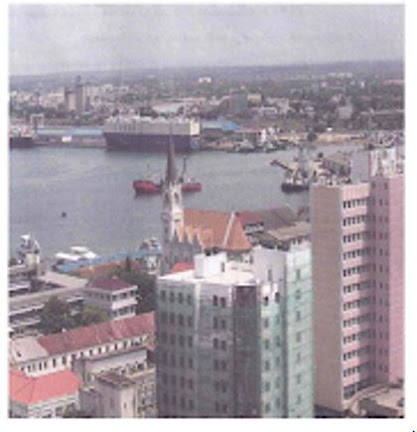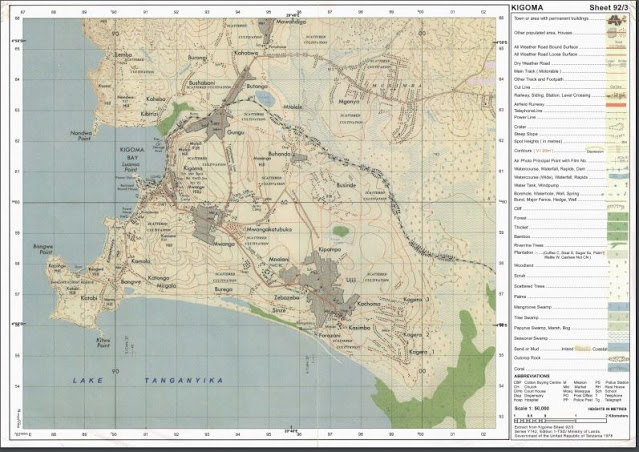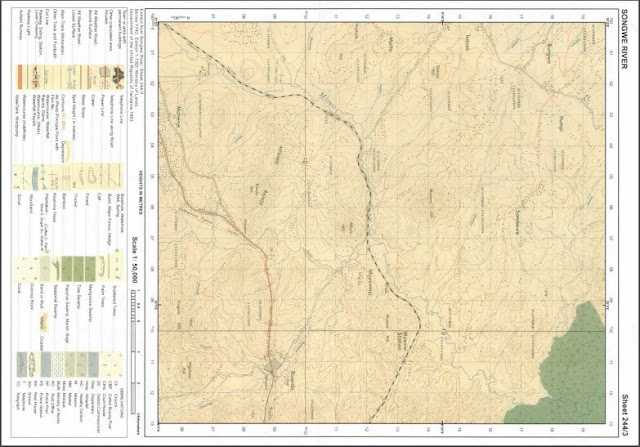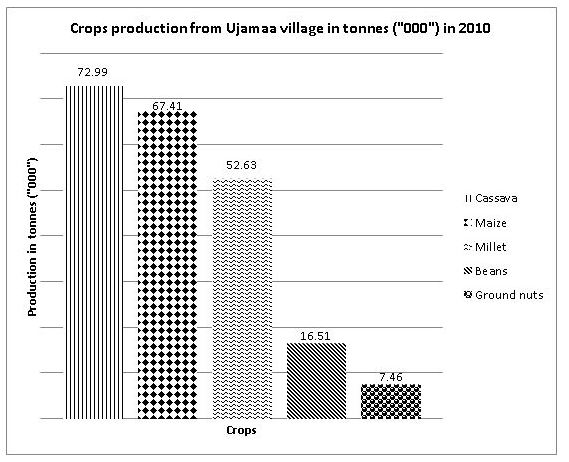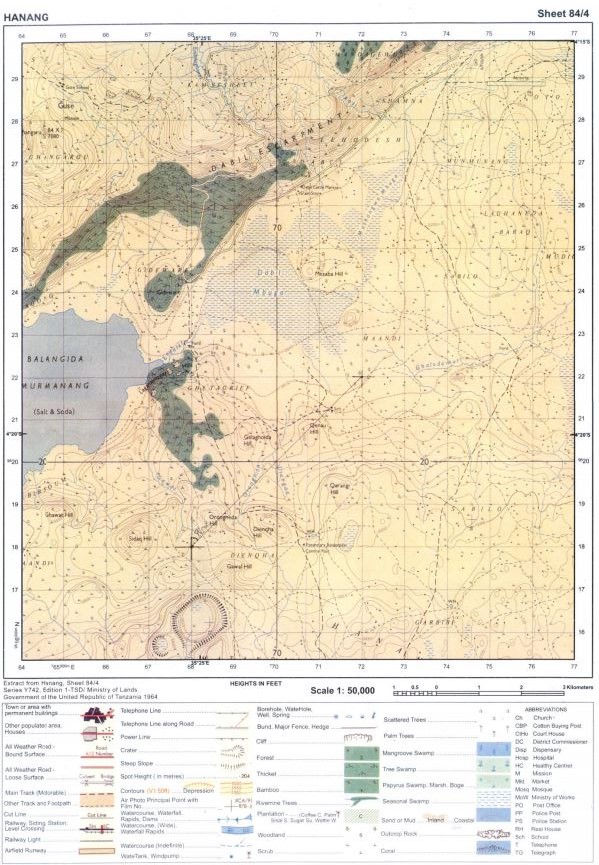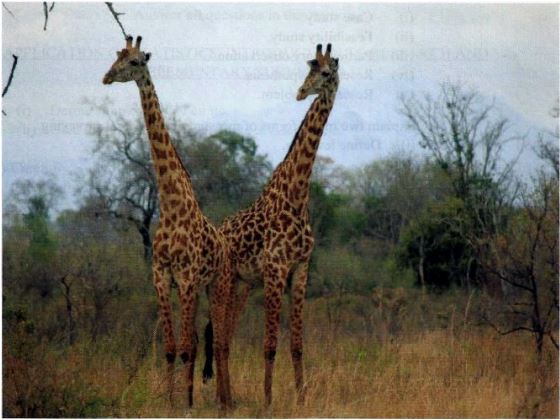DOWNLOAD O-LEVEL GEOGRAPHY NOTES PDF FORM ONE TO FORM FOUR
GEOGRAPHY 2011
(For School Candidates Only)
Time: 3 Hours
Instructions
1. This paper consists of sections A, B, C and D.
2.Answerall questions in sections A, B and C and one (1) question from each part of section D.
3. Map extract of Malampaka (sheet 49/1) is provided.
4. Credit will be given for the use of relevant sketch maps and diagrams.
5. Calculators and cellular phones are not allowed in the examination room.
6.Write your Examination Number on every page of your answer booklet(s)
SECTION A (25 Marks)
Answer all questions in this section.
PHYSICAL AND MATHEMATICAL GEOGRAPHY
1. For each of the items (i) - (x), choose the
correct answer from among the given alternatives and
write its letter beside the item number.
(i) One of the following features is a characteristic of coniferous forests:
A. Trees are made up
of hard wood
B. Trees occur
in stands
C. Trees favour high temperatures
D. Trees have broad
leaves
E. Trees grow in a few
years.
(ii) The Inter-Tropical Convergence Zone (ITCZ) means
A. a region of low pressure
B. a region of doldrums
C. a region of high pressure
D. a sub-tropical high pressure
belt
E. a region with high speed winds.
(iii) Rias often provide natural harbour because they are
A. found along the sub-merged coast
B. mainly found in Europe where the sea is shallow
C. deep outlets of water along the coast
D. not deep, ships can approach ports easily
E. similar to lagoons but have shallow depths.
(iv) If the local time at town X (30°E 45°N) is
5.00 p.m. Monday, what will the time be at
town Y (15°W 50°S)?
A. 2 a.m. Monday
B. 8 p.m. Monday
C. 2 p.m. Monday
D. 3 p.m. Monday
E. 2 p.m. Sunday.
(v) The following are instruments used in chain and tape survey:
A. Barometer, pegs, notebook,
compass
B. Tape measure, chain, cross staff, anemometer
C. Chain, arrows, ranging poles, altimeter
D. Arrows, ranging poles, pegs, chain
E. Cross staff, notebook, chain and plane table.
(vi) When the river flows in its long profile it performs the following geological activities:
A. Moves fast and can carry everything on the earth’s surface
B. Erodes, transports and deposits weathered materials
C. Meanders and forms ox-bow lakes throughout the profile
D.
Does three functions such as abrasion, solution and attrition
E. Acts as agent of weathering and erosion along the
profile.
(vii) If the location of a point on a map is given by grid reference 365490, then
A. 365 are Degrees
B. 365 are Longitudes
C. 490 are Northings
D. 490 are Eastings
E. 365 are Northings.
(viii) The following are the elements of weather:
A. Soils, clouds, dew, humidity, rainfall
B. Fog, barometer, humidity, pressure, air mass
C. Clouds, sunshine, pressure, humidity, thermometer
D. Pressure, clouds, sunshine, humidity, winds
E. Pressure, humidity, soils, fog.
(ix) Which one of the following is not an outcome of the rotation of the earth on its own axis?
A. Deflection of winds and ocean currents
B. Difference of one hour between two meridians 15° apart
C. Day and night
D. Seasons of the year
E. Sunrise and sunset.
(x) Landforms formed by vulcanicity can be divided into
A. Many parts according to the nature of lava
B. Sills, dykes, valleys and earthquakes only
C. Volcanic mountains and sills only
D. Extrusive and intrusive features
E. Batholiths, dykes and volcano only.
CLICK HERE TO GET A MARKING SCHEME (1000 Tshs Only)
2. Match the items in List A with the responses in List B by writing the letter of the correct response beside the item number.
|
List A |
List B |
|
(i) Earth’s zone which is rich in Nickel
and iron
(ii) Erosional feature which is always
formed in the young/upper stage of the river
(iii)Consists of a huge canopy which limits the undergrowth. (iv) The feel of coarseness or softness of
the individual soil particles. (v) A planet in the solar system with
the longest orbit around the sun. |
A Soil texture
B Delta
C Soil structure
D Mantle
E Jupiter F Coniferous forest G Core H Pluto I Tropical rainforest J Interlocking spurs |
SECTION B (27 Marks)
3. Soils may differ from one area but they share almost the same components. Describe the composition of the soil.
Answer all questions this section.
APPLICATION OF STATISTICS, INTRODUCTION TO RESEARCH AND ELEMENTARY SURVEYING
4. Data in the following table show the
enrolment of Form One students at Mji Mpya Secondary
School from 2006 to 2010. Carefully study them and answer the questions that follow.
|
Year |
2006 |
2007 |
2008 |
2009 |
2010 |
|
Number of |
220 |
200 |
150 |
180 |
205 |
(a)Present the data by using simple bar graph
(b)Comment on the trend of the enrolment.
(c)Explain the advantages of the method you have used in (a) above.
5. (a) What is hypothesis formulation?
(b) Explain four importance of hypothesis in
research.
6. Form three students at Nguvumali secondary
school would like to conduct a simple chain
survey around their school compound and measure the height of the big gully near the headmaster’s office.
Describe
the significance of survey in Tanzania.
SECTION C (28 Marks)
Answer all questions in this section.
MAP READING AND PHOTOGRAPH INTERPRETATION
7. Carefully study the map extract of Malampaka (sheet 49/1) provided and answer the following questions:
(a) Calculate the area covered by seasonal swamps in Km square
(b)Explain the distribution of natural vegetation.
(c) How long in kilometres is river Ng’hulu from grid reference
625496 to grid reference
700522?
(d) Identify any three ways which have been used to represent relief in the area.
(e) Through giving evidence, explain any four economic activities
that might be taking place in the area.
8. Carefully
study the following photograph and answer the questions that follow
(a) Such the type of the photograph by giving two reasons.
(b) Suggest any four economic activities that
might be taking place in the area shown on the
photograph.
(c) Comment on the nature of the settlement
pattern as it is portrayed on the photograph.
(d) Explain the relief of the area.
CLICK HERE TO GET A MARKING SCHEME (1000 Tshs Only)
SECTION D (20 Marks)
Answer one (1) question from each part.
PART 1: REGIONAL FOCAL STUDIES
9. (a) Distinguish between large scale and
small scale farming.
(b) What are the advantages of
large scale over small scale farming?
10. “Oil as an economic resource has improved
the living standards of the people of Libya”. Discuss.
PART II: ENVIRONMENTAL ISSUES, POPULATION AND SETTLEMENT
11. Explain the environmental factors which influence population distribution in Tanzania.
12. Suggest the measures to be taken in order
to reduce the effects of global climate change at
national level.
CLICK HERE TO GET A MARKING SCHEME (1000 Tshs Only)
GEOGRAPHY 2012
(For School Candidates Only)
Time: 3
Hours
Instructions
1.This paper consists of sections A, B, C and D.
2.Answer allquestions in sections A, B and C and one (1) question from each part of section D.
3.Map extract of Korogwe (Series Y742 sheet 129/2) is provided.
4.Credit will be given for the use of relevant sketch maps and diagrams.
5.Calculators and cellular phones are not allowed in the examination room.
6.Write your
Examination Number on every page of your answer booklet(s)
SECTION A (25 Marks)
Answer all questions
in this section.
PHYSICAL AND
MATHEMATICAL GEOGRAPHY
1.For each
of the items (i) - (x), choose the correct answer from among the given
alternatives and
write its
letter beside the item number.
(i)The
outer layers of the earth include:
A. Atmosphere,
Lithosphere and Troposphere
B. Atmosphere,
Troposphere and Biosphere
C. Atmosphere,
Hydrosphere and Biosphere
D. Atmosphere,
Lithosphere and Biosphere
E. Atmosphere,
Hydrosphere and Lithosphere.
(ii)Which of
the following is the effect of mass wasting?
A. Frost
action
B. Interlocking
spur
C. Rock
fall
D. Exfoliation
E. Rock disintegration.
(iii)The
columns of clay capped by boulders formed due to rain action are known as:
A. soil
creep
B. gullies
C. land
slide
D. earth
pillars
E. cuesta
(iv)Which of
the following features is formed by river erosion?
A. pot
hole
B. ox
bow lake
C. delta
D. flood
plain
E. lagoon.
(v)Rotation
of the earth results to:
A. elliptical
orbit
B. change
of seasons
C. day
and night
D. leap
year
E. standard
time.
(vi)___________
are good examples of fold mountains in Africa.
A. Uluguru
and Oldoinyo Lengai
B. Jos
and Karoo
C. Elgon
and Kilimanjaro
D. Atlas
and Cape Ranges
E. Udzungwa
and Kilimanjaro.
(vii)Which
one of the following is a process of wind erosion?
A. Abrasion
B. Corrosion
C. Hydrolysis
D. Exfoliation
E. Attrition.
(viii)A
great circle is a circle on a globe whose plane:
A. passes
through the centre of the globe
B. has
the shortest distance between two points
C. is
perpendicular with the globe
D. marks
a line of longitude
E. marks
a line of latitude.
(ix)The
intensity of an earthquake is measured by:
A. epicenter
B. seismograph
C. richter
scale
D. chronometer
E. mercalli
scale.
(x)Soil
texture refers to:
A.
arrangement of soil particle
B.
size of individual soil particles
C.
soil catena
D.
soil PH
E. grained structure.
2.Match the
items in List A with the responses in List B by writing the letter of
the correct
response beside the item number.
|
List A |
List B |
|
(i)The
earth’s zone which is made up of nickel and
iron. (ii)A wall
like feature formed when a mass of magma
cuts across the bedding plane. (iii)The
upper most layer of the earth. (iv)A
sheet of magma which lies along the bedding
plane. (v)Magma
which reaches the earth’s surface and solidifies to form extrusive features. |
A. Crust B. Lava C. Magma D. Mode E. Dyke F. Sill G. Core H. Volcano I.
Batholiths J. Mantle |
3. (a) What
is an earthquake?
(b)
Briefly explain five effects of earthquakes.
(c)
Describe four ways of reducing the risks of earthquakes.
SECTION B (27 Marks)
Answer all
questions this section.
APPLICATION
OF STATISTICS, INTRODUCTION TO RESEARCH AND
ELEMENTARY
SURVEYING
4. Carefully study the hypothetical data presented below showing the export of crops from Tanzania
The Export
of Crops in Tonnes
|
Year |
Cloves |
Sisal |
Cotton |
|
1990 |
4000 |
3500 |
7000 |
|
1991 |
2500 |
2000 |
4500 |
|
1992 |
3500 |
1500 |
6000 |
|
1993 |
6000 |
1000 |
8500 |
|
1994 |
6500 |
1500 |
9000 |
(a)Present
the data using compound bar graph.
(b)Explain two advantages and disadvantages of compound bar graph.
5. (a)What
is meant by sampling techniques as used in research?
(b)Briefly
explain the following concepts as they are applied in sampling:
(i)A
sample
(ii)Random
sampling
(iii)Systematic
sampling
(c)Outline
the procedures of conducting an interview.
6.(a)(i)Define
the term levelling survey.
(ii)State
four benefits of levelling survey.
(b)Explain
essential equipments used in levelling surveying.
SECTION C (28 Marks)
Answer all questions
in this section.
MAP READING
AND PHOTOGRAPH INTERPRETATION
7. Study the
printed map extract of Korogwe (Series Y742 sheet 129/2), then answer the
following questions:
(a)Describe
the relief of the mapped area.
(b)Calculate
the area of the whole map of Korogwe in Kmsquare by using grid squares.
(c)Examine
the settlement patterns of the area.
(d)Express
the scale of the map into statement scale.
8.(a)Name
three types of geographical photographs.
(b)Specify
the type of geographical photograph which is:
(i)taken
horizontally on the ground.
(ii)used
in map making.
(c)Explain
five differences between the photograph you have mentioned in (b) (ii) above
and topographical maps.
SECTION D (20 Marks)
Answer one
(1) question from each part.
PART 1: REGIONAL FOCAL STUDIES
9. By using
concrete examples, explain five negative effects of tourism in East Africa.
10.
Elaborate eight reasons indicating why the transportation sector is important
to the economy of Tanzania.
PART
II:ENVIRONMENTAL ISSUES, POPULATION AND SETTLEMENT
11.Explain
eight environmental problems related to the rapid population growth.
12.(a)Describe
five objectives of conducting census in a country.
(b)Explain
three limitations of census in African countries.
CLICK HERE TO GET A MARKING SCHEME (1000 Tshs Only)
GEOGRAPHY 2013
(For School Candidates Only)
Time: 3 Hours
Instructions
1. This paper consists of sections A, B, C and D.
2. Answer allquestions in sections A, B and C and one (1)
question from each part of section D.
3. Map extract of Kigoma (Series Y742 sheet 92/3) is provided.
4. Credit will be given for the use of relevant sketch maps and diagrams.
5. Calculators and cellular phones are notallowed in the examination room.
6. Write your Examination Numberon every page of your answer
booklet(s)
SECTION A (25 Marks)
Answer all questions in this section.
PHYSICAL AND MATHEMATICAL GEOGRAPHY
1. For each of the items (i) - (x), choose the correct
answer from among the given alternatives and
Write its letter beside the item number.
(i)A cirque is
A. an arm-chair shaped depression on a glaciated
lowland area
B. an arm-chair shaped depression on the sides of a
glaciated mountain
C. an arm-chair shaped depression in the desert areas
D. an arm-chair shaped valley in glaciated areas
E. an arm-chair shaped depression on the plateau.
(ii) A geyser can be described as
A. a hot spring
B. an explosion of volcanic vapour
C. a fountain of superheated water and steam
D. a thermal stream
E. a pool of hot water.
(iii)Which one of the following conditions is
important for the growth of coral reefs?
A. Warm and muddy river
water
B. Warm and muddy sea
water
C. Warm and clear sea
water
D. Warm and clear tape
water
E. Warm and clear
river water.
(iv)A time accepted throughout a time zone of 15° longitude is known as
A. local time
B. noon time
C. Greenwich mean time
D. sun time
E. Standard time.
(v)Which sequence of the following processes is necessary
for the formation of rainfall?
A. Condensation, cooling and evaporation
B. Evaporation, cooling and condensation
C. Evaporation, sedimentation and
cooling
D. Evaporation, condensation and cooling
E. Evaporation, cooling and sedimentation.
(vi) Which of the following instruments is used to
measure pressure?
A. Wet and dry bulb
thermometer
B. Aneroid barometer
C. Anemometer
D. Rain gauge
E. Hygrometer.
(vii) Faulting may lead to the formation of
A. rift valleys
B. moraines
C. ox-bow lakes
D. boulder clays
E. yardangs.
(viii) Which of the following statements is true to an
equatorial region?
A. It has a small annual
range of temperature
B. It has four rainfall
maxima
C. It experiences
temperatures below 20°C
D. It has a high annual
range of temperature
E. It is found
between 15° and 30° north and south of the equator.
(ix) The earth’s crust is also known as
A. Atmosphere
B. Hydrosphere
C. mantle
D. lithosphere
E. troposphere.
(x)What is the compass bearing of WNW?
A. 270°
B. 337°
C. 315°
D. 327°
E. 292°
2. Match the items in List A with the responses in List
Bby writing the letter of the correct
response beside the item number.
|
List A |
List B |
|
(i) A tidal wave formed as a result of an Earthquake or volcanic eruption. (ii) Denser rocks that form the ocean floor. (iii) A force that causes the bending of the earth’s
crust. (iv) Intrusive volcanic feature formed Horizontally along the bedding plane. (v)Formed when two caves on opposite sides of headland
join up. |
A. Compression B. Dyke C. Sial D. Ocean currents E. Faulting F. Arch G. Sima H. Tsunami I. Stack J. Sill |
3. With the aid of diagram, explain any five features formed by wave
deposition.
CLICK HERE TO GET A MARKING SCHEME (1000 Tshs Only)
SECTION B (27 Marks)
Answer all questions this section.
APPLICATION OF STATISTICS, INTRODUCTION TO RESEARCH AND
ELEMENTARY SURVEYING
4.(a)Explain the meaning of the standard deviation.
(b)Study the following data showing the age of the Primary
School pupils at Tumaini
Primary School and answer the questions that follow: 15, 8,
7, 6, 12, 5, 14 and 13.
(i)Determine the range and median of the age of the pupils.
(ii)Calculate the standard deviation.
5.(a)What is research?
(b)Explain four benefits of conducting
research.
6.(a)Explain the best steps required in order to conduct an
accurate chain survey.
(b)What are the five good booking methods used
in chain survey?
SECTION C (28 Marks)
Answer all questions in this section.
MAP READING AND PHOTOGRAPH INTERPRETATION
7. Study the printed map extract of Kigoma
(Series Y742 sheet 92/3), then answer the following
questions:
(a)By using the vertical scale of 1cm to 20m, draw a cross
section from grid reference 91057
to grid reference 932620 and determine its Vertical
Exaggeration (V.E).
(b)With vivid evidence from the map, mention the major types
of transport shown in the
area.
(c)Apart from fishing activities, use concrete evidence to
name other economic activities
Taking place in the area.
(d)In which hemisphere is the mapped area located? Give
evidence for your answer.
8.Study the photograph given below and then answer the
questions that follow:
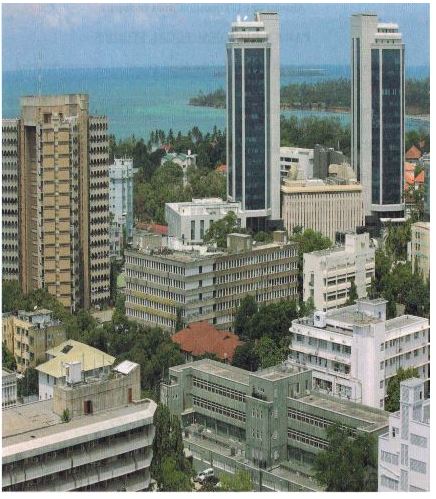
(a)Identify the type of photograph. Give concrete evidence
(b)By providing evidence from the photograph, describe
the relief of the area.
(c)Explain three possible factors which have
contributed to the growth of this town.
(d)Apart from providing shade, explain any other three
advantages of the vegetation shown
on the photograph.
SECTION D (20 Marks)
Answer one (1)question from each part.
PART 1: REGIONAL FOCAL STUDIES
9. Explain six factors which account for the development of
car manufacturing industry in Japan.
10. Describe six problems facing railway transportation in
East Africa.
PART II: ENVIRONMENTAL ISSUES, POPULATION AND SETTLEMENT
11. Elaborate siximportance of Mount Kilimanjaro to
Tanzania.
12. Examine six effects of environmental pollution in African cities.
GEOGRAPHY 2014
(For Both School and Private Candidates)
Time: 3 Hours
Instructions
1. This paper consists of sections A, B, C and D.
2. Answer allquestions in sections A, B and C and one
(1) question from each part of section D.
3. Map extract of Songwe River (sheet 244/3) is
provided.
4. Credit will be given for the use of relevant sketch
maps and diagrams.
5. Calculators and cellular phones are not allowed
in the examination room.
6. Write yourExamination Number on every page of
your answer booklet(s)
FREE STUDY MATERIALS DOWNLOAD PDF TANZANIA SYLLABUS
SECTION A (25 Marks)
Answer allquestions in this section.
PHYSICAL AND MATHEMATICAL GEOGRAPHY
1. For each of the
items (i) - (x), choose the correct answer from among the given alternatives
and
Write its letter beside the item number in the answer
booklet provided.
(i) Zeugens and yadangs differ in
A position of the rock strata
B position of the rock in the slope
C place of formation
D colour of the rock on which they are
formed
E the type of the rock on which they are
formed.
(ii) An old age stage of the river is called
A Valley Stage
B Torrent Stage
C Plain Stage
D Mature Stage
E Youthful Stage.
(iii) The summer solstice in the northern hemisphere
occurs on
A23rd September
B 21st September
C 22nd December
D 21st March
E 21st June.
(iv) A Stevenson’s box is painted by white colour in
order to
A improve insulation
B be seen clearly
C decorate it
D allow thermometers to be placed
(v) A stony desert is called
A Hamada
B reg
C barchan
D erg
E rock pedestal.
(vi) The temperature at Korogwe 950 metres is 24°C.
What is the temperature of Kilimanjaro 5895 metres above sea level?
A 34°C.
B 5.67°C.
C 18.1°C.
D10.24°C.
(vii) When two lateral forces act away from each other are
known as
A horizontal forces
B orogenic forces
C vertical forces
D compression forces
E tension forces.
(viii) Water vapour is turned into water droplets in the
process known as
A evaporation
B convection
C saturation
D condensation
E transpiration.
(ix) Which of the following features produced by ice action
is the result of both erosional and
depositional activities?
A Arête.
B Hanging Valley.
C Erratic.
D Cirque.
E Roche Mountonee.
(x) The name given to earthquake waves that travel within a
crust is
A focus
B epicenter
C seismic
D surface waves
2. Match the items in List A with the responses in List
B by writing the letter of the correct response beside the item
number in the answer booklet provided.
|
List A |
List B |
|
(i)A mass of magma which has emerged on the earth’s surface. (ii)A wall like feature formed when magma cuts across a bedding plane. (iii)A sheet of magma which lies along a bedding plane. (iv)A very large mass of magma which often forms the root of a mountain. (v)A dome-shaped feature formed when magma push up the overlaying layers. |
A laccoliths B caldera C sills D volcano E lava F crater G dyke H cone let I batholiths J lava cones |
3. (a)Explain four mechanisms developed by plants in semi
arid regions to adapt drought conditions. (b)Describe
the characteristics of equatorial forest.
SECTION B (27 Marks)
Answer all questions this section.
APPLICATION OF STATISTICS, INTRODUCTION TO RESEARCH AND
ELEMENTARY
SURVEYING
4.The table below shows agricultural production in Tanzania
from 2000 to 2006 in `000 tonnes.
|
CROPS |
2000 |
2001 |
2002 |
2003 |
|
Maize |
65 |
35 |
60 |
70 |
|
Tobacco |
25 |
30 |
20 |
25 |
|
Coffee |
50 |
60 |
45 |
45 |
(a)Present the data by using a grouped line graph.
(b)Comment on the nature of production.
5. (a)What is a research problem?
(b)Name four sources of research problem.
(c)Explain four characteristics of research problem.
6. (a)Define chain survey.
(b)Give the main use of the following equipments in simple
chain survey.
(i)Pegs
(ii)Cross staff
(iii)Arrows
(iv)Tape
(v)Chain
(vi)Ranging rods
(vii)Field sheet
SECTION C (28 Marks)
Answer allquestions in this section.
MAP READING AND PHOTOGRAPH INTERPRETATION
7. Study the printed map extract of Songwe River
(sheet 244/3), then answer the following questions:
(a)Calculate the area covered by forest in km square by
using grid square method.
(b)Measure the length of railway line form grid
references 040118 to 130122.
(c)Describe the nature of the relief of the area.
(d)Name four physical features found on the map.
(e)Giving evidences from the map, suggest three
economic activities taking place in the area.
8. Study the photograph given below and then answer the
questions that follow:
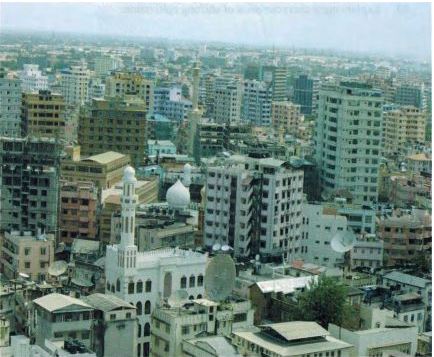
(a)With two reasons, identify the type of the
photograph.
(b)Identify the type of the settlement pattern seen on
the photograph.
(c)Name two economic importances of the area shown on
the photograph.
(d)Explain two social and environmental problems that
are likely to occur in the area.
SECTION D (20 Marks)
Answer one (1) question from each part.
PART 1: REGIONAL FOCAL STUDIES
9.Suggest eight ways that may be adopted to solve the
problems facing forestry in Tanzania.
10.Explain eight characteristics of shifting cultivation.
PART II: ENVIRONMENTAL ISSUES, POPULATION AND SETTLEMENT
11.Describe the natural and human causes of loss of
biodiversity.
12.Examine the eight factors which lead to the growth of settlements in different parts of a country.
GEOGRAPHY 2016
(For Both School and Private
Candidates)
Instructions
1.This paper consists of sections A, B, C and D.
2.Answer all questions in sections A, B and C and one (1) question from each part of section D.
3.Map extract of Hanang (Sheet 84/4) is provided.
4.Calculators and Cellular phones are not allowed in the examination room.
5.Write your Examination Number on every page of your answer booklet(s)
SECTION A (25 Marks)
Answer all questions in this section.
PHYSICAL AND MATHEMATICAL GEOGRAPHY
1.
1. For each of the items (i) - (x), choose the correct answer from among the given alternatives and write its letter in the answer booklet provided.
(i) The speed of the earth quake waves in the earth is changed at a line called
A.Mohorovic discontinuity
C.Tectonics
E.Isostatic.
(ii) Liverpool team scored a goal at
5.00 pm in England (15° W). At what time
the goal was scored in Dar es Salaam (45° E)
A. 1.00 p.m
D. 9.00 p.m
E. 6.30 a.m.
(iii) The sun is overhead at tropic of Capricorn every
year on
A. 22nd December
B. 21st March
C. 23rd September
D. 21st June
E. 24th March.
(iv) Day reaches its maximum length on 21st June in
A. Southern hemisphere
B. Northern Hemisphere
(v) Which of the following planets have small celestial bodies in orbit around them?
.A. Mercury, Jupiter and Uranus
B. Pluto, Earth and Mars
C. Earth, Jupiter and Saturn
D. Mercury, Venus and Earth
E. Venus, Earth and Saturn.
(vi) Deposition of soil materials removed from one horizon to another is called
A. Convex sided
B. Concave sided
C. Gentle sided resistance
D. Steep sided resistant
E. Steep sided non resistance.
(vii) The excessive strong wind blowing across an extensive ocean surface is called
A. Tsunami
B. Ocean currents
C. Storm surge
D. Hurricane
E. Wind.
(viii) Rainfall that occurs when the air moves towards a hill or a mountain is called
A. cyclonic
B. orographic
C. convectional
D. showers
E. typhoon.
(ix) Mountains can be classified on the basis of
A. their importance
B. their surrounding
C. their composition
D. their formation
(x) A
channel diverging from the main
river and flowing into the sea or a lake by a separate mouth is called
A. tributary
B. stream
C. distributary
D. river basin
2. Matchatch the items in List A with the responses in List B by writing the letter of the correct response besides the item number in the answer booklet provided.
|
List A |
List B |
|
(i) Water that flows out of the ground.
(ii) Water that seep out of rocks and into the rock holes.
(iii) Water that enters the rocks of the earth’s
surface.
(iv) Interaction of water vapour, precipitation,
infiltration, run off, evaporation
and condensation.
(v) Water that is saturated in permeable
rocks. |
A.Stalagmite B. Doline C. Water cycle D. Artesian basin E. Aquifer F. Uvula G. Spring H. Ground water I. Juvenile water J. Bore holes K. Well |
3. (a) Describe discordant drainage system.
(b) Explain the process of river transport and describe four ways in which a river transports its load.
CLICK HERE TO GET A MARKING SCHEME (1000 Tshs Only)
SECTION B (27 Marks)
Answer all questions this section.
APPLICATION OF STATISTICS, INTRODUCTION
TO RESEARCH AND ELEMENTARY SURVEYING
4.(a) (i) Define simple divided
circle.
(ii) Give four merits of using simple
divided circle.
(b)Carefully study the bar graph presented below showing production of crops in tonnes (“000”) from Ujamaa village in 2010, and then answers the questions that follow.
(i) Draw the above bar graph to a simple divided circle by showing all the procedures.
(ii)Give two possible factors for variation of crops production in the above bar graph provided.
5.(a) Point out four objectives of doing research in Tanzania
(b) Describe the following terms as used in research:
(i) Case study
(ii) Feasibility study.
(iii) Participatory observation.
(iv) Research hypothesis.
(v) Research problem.
6 (a)Explain two major forms of measurements in land surveying.
(b) (i) Define leveling.
(ii) Explain four significances
of leveling.
CLICK HERE TO GET A MARKING SCHEME (1000 Tshs Only)
SECTION C (28 Marks)
Answer all questions in this section.
MAP READING AND PHOTOGRAPH INTERPRETATION
7. Carefully
study the map extract of Hanang (Sheet 84/4) provided and answer the following questions:
(a) Express the map scale
as a statement.
(b) Find the bearing of grid reference 720220 to 680180.
(c) Giving three evidences
from the map, suggest the climate of the mapped area.
(d) Suggest with evidence, five major economic
activities which might take place in
the area.
(e) Give four supportive contents of a topographical map
provided.
(f) Mention three factors which affected
the contents of the map given.
8. Study the photograph provided below and then answer the questions that follows:
(a) Name the type of photograph.
(b) Give three characteristics of the type of photograph in (a) above.
(c) Explain four possible factors which may cause the
loss of biodiversity in the
photograph.
(d) Give two economic importance
of the area.
(e) In three points, describe the importance of
the vegetation shown in the area.
SECTION D (20 Marks)
Answer one (1) question from each part.
PART 1: REGIONAL
FOCAL STUDIES
9. Evaluate six
factors that determine exploitation of minerals in a country.
10. Explain six factors that hinder development of river transportation in Africa.
PART II: ENVIRONMENTAL
ISSUES, POPULATION AND SETTLEMENTS
11. Describe five measures
to control floods to the
environment.
12. Analyse eight problems
associated with growth of urban settlement.
CLICK HERE TO GET A MARKING SCHEME (1000 Tshs Only)
Searched Tags:
o level geography paper, o level
geography past papers, o level geography questions and answers pdf, o-level geography syllabus
in tanzania pdf, o-level geography syllabus 2020, o level
geography syllabus 2021, geography o-level syllabus 2010 pdf, 2020 o
level geography paper, geography necta questions, necta 2019, geography
necta 2020, geography necta review, geography necta 2010, geography
necta 2021, geography necta form four 2020, geography necta form
four 2019.
Searched Tags:
